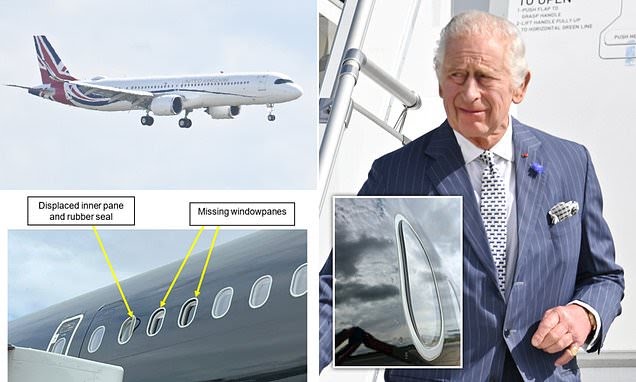NFL
Plane used by King Charles is forced to make emergency landing after external windows fell out at 14,000ft: Frames on Titan Airways Airbus were melted by lights used to film an advert

A plane previously used by King Charles saw one of its windows fall out after having its frames melted by lights used to film an advert, a report has revealed.
Three windows on the Titan Airways Airbus fell out while the plane 14,000ft in the air last October, after it took off from London Stansted Airport on a flight to Florida.
Passengers noticed ‘increased cabin noise’ and a crew member discovered one window was visibly loose in its frame.
The aircraft returned to Stansted after 36 minutes and none of the 24 people on board were injured.
Staff discovered a total of three windows were missing after landing and also saw fresh impact damage on the plane’s tail.
Prime Minister Rishi Sunak and Foreign Secretary James Cleverly also used it on official trips abroad.
The Airbus’ acrylic windows had shrunk after being exposed to ‘high intensity’ lights used for filming an advert the previous day, analysts at Air Accidents Investigation Branch (AAIB) found.
Film technicians positioned high intensity halogen lights outside the airliner’s fuselage as advertisers filmed some promotional footage on board the plane.
This light shone in through the windows to create a sunrise effect whilst advertisers filmed on board the plane the day before the incident.
The six lights used had a combined lighting capacity of 72,000 watts – more than seven hundred times greater than a household light bulb.
The AAIB report – first published in the Daily Telegraph – said: ‘The lights were first shone on the right side of the aircraft for approximately five and a half hours, with the light focused on the cabin windows just aft of the overwing exits.
‘The lights were then moved to the left side of the aircraft where they illuminated a similar area on the left side for approximately four hours.’
According to data from a light manufacturer, surfaces that are six metres away could see temperatures rise by as much as 147F (64C).
On the Airbus that day, technicians placed the lights between six and nine metres away.
All the scratch panes remained in place during the flight, meaning there was’ no direct unrestricted aperture between the passenger cabin and the outside air’, the AAIB said.
The AAIB has not disclosed who the advertiser was and there is no suggestion in their report that any Airbus manufacturing defect was to blame for the airliner’s windows melting.
A Titan Airways spokesman said: ‘We would like to thank the members of the AAIB team for their extremely thorough and professional investigation.
‘The aviation industry as a whole will benefit from the lessons learnt from this event.
‘We are also pleased to hear that our colleagues at Airbus will be circulating further information to its worldwide customer base, highlighting the potential damage that can be caused by high-intensity lighting.
We are also grateful to all of our crew members onboard, whose swift and professional handling of the incident was exemplary.’
While it was used for royal and Government flights, the airliner was registered G-GBNI and was painted white with a Union flag logo on the tail.
The Airbus was re-registered G-OATW and repainted in a black colour scheme, after the Government charter ended.




![[First degree murder charge] Man arrested in the deadly shooting of 12-year-old girl in Southeast Baltimore](https://usatune.com/wp-content/uploads/2024/07/4723e31b5fd1547749b0ff0fabb250ad-80x80.jpg)

![“Goodbye, Legend!” Emma Heming Shares Heartbreaking News About Bruce Willis, A good day to die hard the Actor’s Latest Developments [Tragic]](https://usatune.com/wp-content/uploads/2024/07/451047620_1664828077616493_1970708724494300183_n-80x80.jpg)






